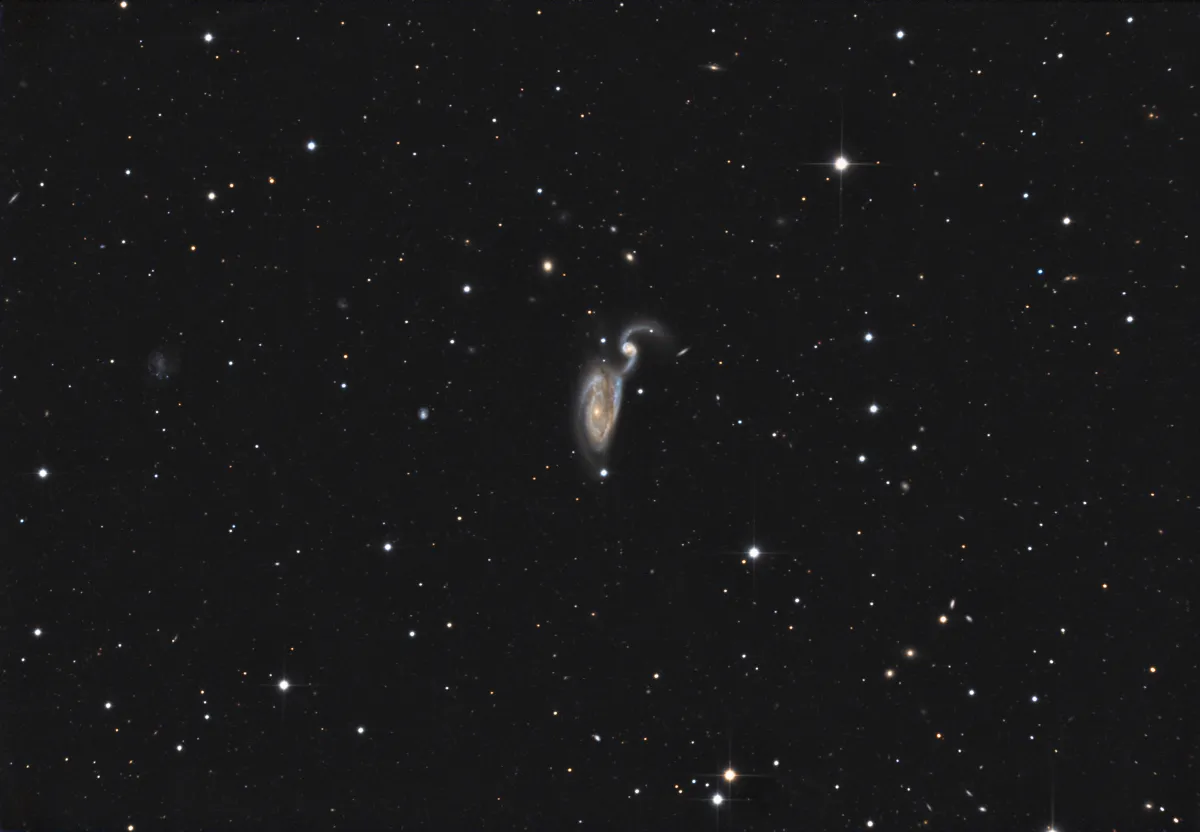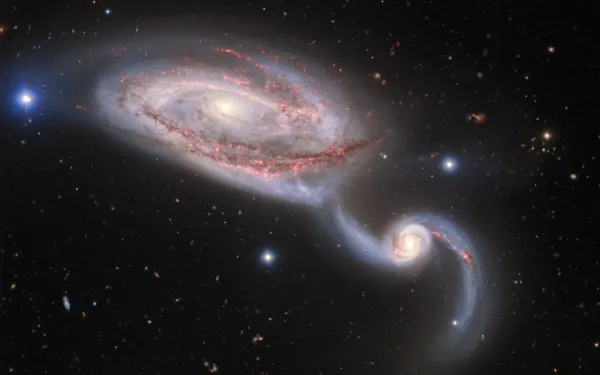Heron Galaxy (NGC 5394/5)

History
The pair of galaxies NGC 5394/5 was discovered on 16 May 1787 by the German-British astronomer William Herschel with his self-made 18.7 inch f/12.8 reflecting telescope in Slough, England. He cataloged it as I 190 and I 191. He noted: «Two. The south considerably bright, considerably large. The north pretty bright, small. Distance 1.5'.» The same night he discovered NGC 5380 (II 698). [464]
His son John found NGC 5378 with his 18.3 inch telescope 11 March 1831. The small galaxy IC 4356 was discovered on 19 June 1897 by the French astronomer Stephane Javelle using the 76 cm refractor telescope at the Observatoire de Nice. [196, 277]

The pair of galaxies NGC 5394/5 is listed as VV 48 in the «Atlas and Catalogue of Interacting Galaxies» [432] published by B. A. Vorontsov-Velyaminov in 1959. In Halton Arp's 1966 «Atlas of Peculiar Galaxies», the two interacting galaxies below Arp 84 are found as an example of a galaxy with a large companion of high surface brightness. [199]
Because of the appearance of this unusual pair of galaxies, which resembles a heron standing in wait, it was nicknamed the «Heron Galaxy».

Physical Properties
NGC 5395 is a Seyfert Type II spiral galaxy. It is interacting with the smaller companion NGC 5354 which shows two open tidal arms and also starburst activity in its centre region. This could be the result of a past collision, which was shown with model calculations. Distances to the galaxy pair NGC 5394/5 range from 50 Mpc to 54 Mpc (163 bis 178 million light-years). The larger galaxy (NGC 5395) is 140'000 light-years across and the smaller one (NGC 5394) is 90'000 light-years across. [145, 506, 507]
| Name | RA | Dec | Type | bMag | vMag | B-V | SB | Dim | PA | z | D(z) | Dreyer Description | Identification, Remarks |
|---|---|---|---|---|---|---|---|---|---|---|---|---|---|
| NGC 5378 | 13 56 50.9 | +37 47 50 | Gx (SBa) | 13.4 | 12.5 | 0.9 | 14.3 | 2.7 × 2.2 | 90 | 0.010147 | 42.86 | pB, lE, vglbM | h 1713; GC 3717; UGC 8869; MCG 6-31-27; CGCG 191-20 |
| NGC 5380 | 13 56 56.7 | +37 36 37 | Gx (E-S0) | 13.3 | 12.3 | 1.0 | 13.3 | 1.7 × 1.7 | 0.010584 | 44.71 | F, cS, R, smbM | WH II 698; h 1714; GC 3718; UGC 8870; MCG 6-31-28; CGCG 191-21 | |
| NGC 5394 | 13 58 33.7 | +37 27 13 | Gx (SBb/P) | 13.7 | 13.0 | 0.7 | 13.4 | 1.9 × 1.3 | 0 | 0.011501 | 48.58 | cF, S, np of 2 | WH I 191; h 1722; GC 3730; UGC 8898; MCG 6-31-33; CGCG 191-24; IRAS 13564+3741; KCPG 404A; VV 48; Arp 84; KUG 1356+376A; Z 1356.4+3742 |
| NGC 5395 | 13 58 37.9 | +37 25 31 | Gx (Sb) | 12.1 | 11.4 | 0.7 | 12.8 | 2.7 × 1.3 | 2 | 0.011711 | 49.47 | cF, cL, E 15°, lbM, sf of 2 | WH I 190; h 1723; GC 3731; UGC 8900; MCG 6-31-34; CGCG 191-26; KCPG 404B; 1ZW 77; VV 48; Arp 84; KUG 1356+376B |
| IC 4356 | 13 58 45.0 | +37 29 28 | Gx (C) | 16.0 | 15.0 | 1.0 | 12.2 | 0.3 × 0.3 | 0.050207 | 212.0 | F, vS, stell N = * 15 | NPM1G +37.0419 |
Finder Chart
Although the pair of galaxies are in the constellation Canes Venatici, it is better to use the constellation Bootes for finding. Extend the line connecting the two stars Nekkar (β Boötis) and Seginus (γ Boötis) by the same amount and set the outermost Telrad circle north of it at right angles. The best observation time is December to September, when the constellation is at its highest at night.
Visual Observation
320 mm Aperture: The galaxy pair NGC 5394/5 is said to represent a gray heron. Only it was upside down or astronomically correct. The two parts of the galaxy could be seen well, with the smaller galaxy only revealing the bright core. The beak or the fine spiral arm was not visible. — 12.5" f/4.5 Ninja-Dobsonian, Glaubenberg, 25. 3. 2022, Eduard von Bergen
400 mm Aperture: At low magnification (21 mm Tele Vue Ethos, 85x) the galaxy pair NGC 5394/5 can be easily missed as it appears dimmer than the DSS overview map suggests. It reveals itself here only as an elongated, irregular nebula. At higher magnification (9 mm Nagler, 200x) the pair of galaxies becomes more visible. From the head of the heron (galaxy NGC 5394), however, only the core area can be seen. No spirals. This requires much more aperture. — Taurus T400 f/4.5 Dobsonian, Glaubenberg, 25. March 2022, 22:50 CET, SQM-L 21.1, Bernd Nies
